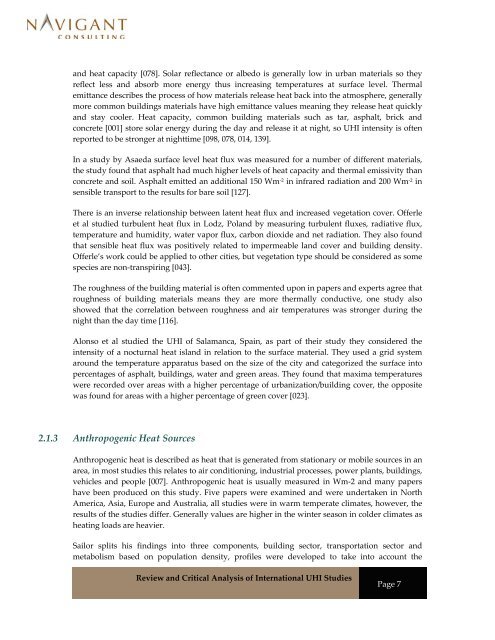Review and Critical Analysis of International UHI Studies
Review and Critical Analysis of International UHI Studies
Review and Critical Analysis of International UHI Studies
Create successful ePaper yourself
Turn your PDF publications into a flip-book with our unique Google optimized e-Paper software.
<strong>and</strong> heat capacity [078]. Solar reflectance or albedo is generally low in urban materials so they<br />
reflect less <strong>and</strong> absorb more energy thus increasing temperatures at surface level. Thermal<br />
emittance describes the process <strong>of</strong> how materials release heat back into the atmosphere, generally<br />
more common buildings materials have high emittance values meaning they release heat quickly<br />
<strong>and</strong> stay cooler. Heat capacity, common building materials such as tar, asphalt, brick <strong>and</strong><br />
concrete [001] store solar energy during the day <strong>and</strong> release it at night, so <strong>UHI</strong> intensity is <strong>of</strong>ten<br />
reported to be stronger at nighttime [098, 078, 014, 139].<br />
In a study by Asaeda surface level heat flux was measured for a number <strong>of</strong> different materials,<br />
the study found that asphalt had much higher levels <strong>of</strong> heat capacity <strong>and</strong> thermal emissivity than<br />
concrete <strong>and</strong> soil. Asphalt emitted an additional 150 Wm ‐2 in infrared radiation <strong>and</strong> 200 Wm ‐2 in<br />
sensible transport to the results for bare soil [127].<br />
There is an inverse relationship between latent heat flux <strong>and</strong> increased vegetation cover. Offerle<br />
et al studied turbulent heat flux in Lodz, Pol<strong>and</strong> by measuring turbulent fluxes, radiative flux,<br />
temperature <strong>and</strong> humidity, water vapor flux, carbon dioxide <strong>and</strong> net radiation. They also found<br />
that sensible heat flux was positively related to impermeable l<strong>and</strong> cover <strong>and</strong> building density.<br />
Offerle’s work could be applied to other cities, but vegetation type should be considered as some<br />
species are non‐transpiring [043].<br />
The roughness <strong>of</strong> the building material is <strong>of</strong>ten commented upon in papers <strong>and</strong> experts agree that<br />
roughness <strong>of</strong> building materials means they are more thermally conductive, one study also<br />
showed that the correlation between roughness <strong>and</strong> air temperatures was stronger during the<br />
night than the day time [116].<br />
Alonso et al studied the <strong>UHI</strong> <strong>of</strong> Salamanca, Spain, as part <strong>of</strong> their study they considered the<br />
intensity <strong>of</strong> a nocturnal heat isl<strong>and</strong> in relation to the surface material. They used a grid system<br />
around the temperature apparatus based on the size <strong>of</strong> the city <strong>and</strong> categorized the surface into<br />
percentages <strong>of</strong> asphalt, buildings, water <strong>and</strong> green areas. They found that maxima temperatures<br />
were recorded over areas with a higher percentage <strong>of</strong> urbanization/building cover, the opposite<br />
was found for areas with a higher percentage <strong>of</strong> green cover [023].<br />
2.1.3 Anthropogenic Heat Sources<br />
Anthropogenic heat is described as heat that is generated from stationary or mobile sources in an<br />
area, in most studies this relates to air conditioning, industrial processes, power plants, buildings,<br />
vehicles <strong>and</strong> people [007]. Anthropogenic heat is usually measured in Wm‐2 <strong>and</strong> many papers<br />
have been produced on this study. Five papers were examined <strong>and</strong> were undertaken in North<br />
America, Asia, Europe <strong>and</strong> Australia, all studies were in warm temperate climates, however, the<br />
results <strong>of</strong> the studies differ. Generally values are higher in the winter season in colder climates as<br />
heating loads are heavier.<br />
Sailor splits his findings into three components, building sector, transportation sector <strong>and</strong><br />
metabolism based on population density, pr<strong>of</strong>iles were developed to take into account the<br />
<strong>Review</strong> <strong>and</strong> <strong>Critical</strong> <strong>Analysis</strong> <strong>of</strong> <strong>International</strong> <strong>UHI</strong> <strong>Studies</strong><br />
Page 7


